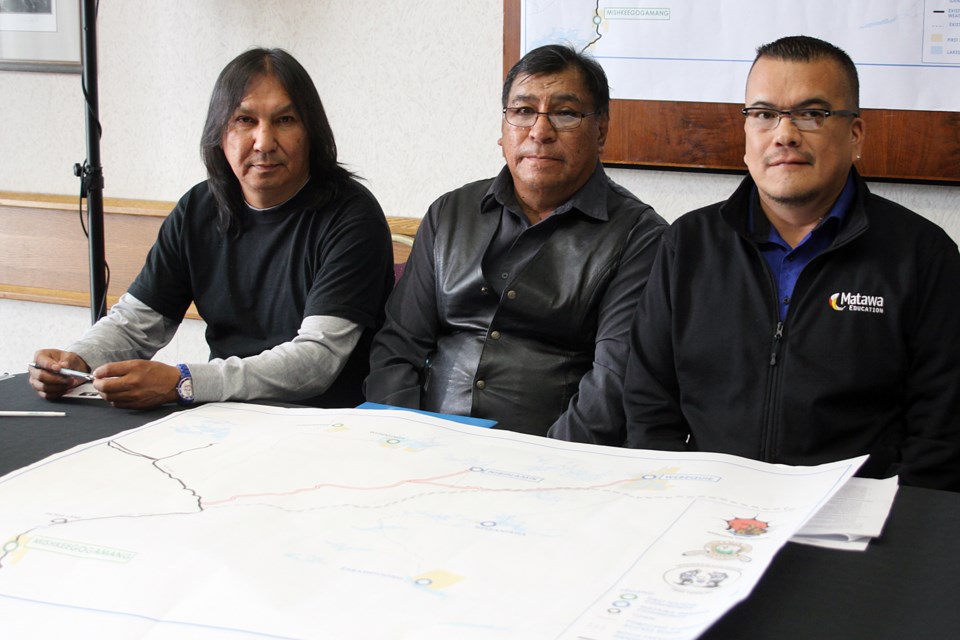THUNDER BAY – The province’s declaration that an agreement has been reached to construct road access into the Ring of Fire is premature, say leaders of two Matawa First Nations part of the announcement earlier this week.
Nibinamik Chief Johnny Yellowhead and Webequie Chief Cornelius Wabasse held a Friday afternoon news conference in Thunder Bay, the purpose of which they said was to provide clarity that their agreement was to conduct a study on identifying an infrastructure corridor that could include connecting their respective communities to the provincial highway network.
“We’re not moving forward with anything. It’s just a study we wanted to do from Webequie to Nibinamik to get that all-season, community service road between the two First Nations before we can work collaboratively with other First Nations,” Yellowhead said. “There are going to be phases to it.”
Premier Kathleen Wynne was in Thunder Bay on Monday, where she was joined by Wabasse and Marten Falls First Nation Chief Bruce Achneepineskum to announce provincial partnership for two separate road corridors that would connect the remote Ring of Fire area communities to existing highways.
The news release issued by the province on Monday – titled Ontario and First Nations Moving Ahead with Road to Ring of Fire – stated “Ontario will support First Nations to plan and construct an east-west road connecting the Webequie and Nibinamik communities to the provincial highway network north of Pickle Lake. This project would provide all-season access to both First Nations communities as well as into the Ring of Fire Development.”
A map provided by Nibinamik and Webequie on Friday shows the proposed route extending north of the highway from Pickle Lake branching off to Nibinamik and terminating at Webequie. A map provided by the province on Monday shows the route continuing southeast from Webequie into the Ring of Fire.
The chiefs of both Neskantaga and Eabametoong First Nations – two other Matawa communities – on Thursday said the road would not go ahead without jurisdictional agreements from all area communities.
“The reality is that all the roads to the Ring of Fire traverse the territory of our Nations, and nothing is happening without the free, prior, and informed consent of our First Nations,” Neskantaga Chief Wayne Moonias said in a statement.
In a statement, Northern Development and Mines Minister Michael Gravelle said Nibinamik, Webequie, Neskantaga and Eabametoong all completed the first phase of a road study last year.
"Some communities are at a point where they are ready to build on the work undertaken in the first phase of the study and we are working directly with these communities to advance their interests around community access roads," Gravelle said. "The government is supporting Webequie, Marten Falls and Nibinamik First Nations with their planning and construction for all-season access to their communities and to the Ring of Fire.
Yellowhead acknowledged the frustration of those two communities and said he understands their position.
“I would be really upset too if I wasn’t properly consulted or properly informed of what was going to take place,” Yellowhead said, adding the province's timeline of having shovels in the ground in 2019 might be too ambitious.
Wabasse said he recognizes the concerns of the other communities but also appreciates the pressure on the provincial government to act.
“It is premature in a way but I think we need to start moving forward on our processes,” Wabasse said. “It’s not to say we’re not going to do away with our processes we have in place. We still need to work on those. The announcement is contingent on that.”
Both Yellowhead and Wabasse said they remain optimistic the nine Matawa communities – which signed a Regional Framework Agreement with Ontario in 2014 and have been participating in a jurisdictional table with the government – can move forward cooperatively.
“We need to keep engaging. We need to keep talking and come up with somethings that need to be understood,” Wabasse said.
“I think all of the First Nations have always said they’re not opposed to development, they need to see and make sure all processes are finalized before major development can happen in the area.”
